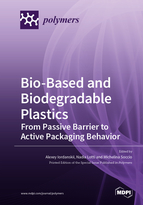Bio-Based and Biodegradable Plastics: From Passive Barrier to Active Packaging Behavior
A special issue of Polymers (ISSN 2073-4360). This special issue belongs to the section "Polymer Applications".
Deadline for manuscript submissions: closed (30 April 2020) | Viewed by 45755
Special Issue Editors
Interests: biodegradable polymers; transport phenomena; electrospun fibers; controlled release; polymer blends; composites; water in macromolecular systems; sorption; gas permeability
Special Issues, Collections and Topics in MDPI journals
Interests: polymer design; polymer synthesis and characterization; polymer modification; copolymerization; solid state properties; thermal properties and crystallization kinetics; mechanical characterization; bio-based monomers; bio-based polymers; nano-polymer; nanocomposites; gas barrier behaviour; polymer compostability; biopolymers for engineering tissue; polymeric for controlled drug delivery; biodegradation
Special Issues, Collections and Topics in MDPI journals
Interests: polymer synthesis; polymer modification; copolymerization; polymer characterization; solid state properties in polymers; polymer thermal properties; polymer crystallization kinetics; mechanical characterization; bio-based monomers; biopolymers; biomaterials; polymer nanostructuring; nanocomposites; gas barrier properties; polymer compostability; biopolymers for tissue engineering; polymeric devices for controlled drug delivery; biodegradation
Special Issues, Collections and Topics in MDPI journals
Special Issue Information
Dear Colleagues,
Over the few coming decades, bio-based and biodegradable plastics produced from sustainable bioresources should essentially substitute the prevalent synthetic plastics produced from exhaustible hydrocarbon fossils. To the greatest extent, this revolutionary trend has to be applied to the packaging manufacturing area, and especially to food packaging implementation.
Currently, polymer packaging wastes that cannot be decomposed in an eco-friendly manner at landfill sites generate a series of severe environmental challenges. In spite of the urgent need to use bioplastics, their global production capacity is in fact rather limited and in 2018 amounted to 2.1 million tons, i.e., less than 1% of total polymer production. Biodegradable plastics are produced in even smaller quantities, about 0.9 MT, but in accordance with the prognosis of European Bioplastics Nova Institute, in the next 5 years, their manufacturing will grow by ~45% and approach 1.3 MT annually. To supply rapid production, an increment of biodegradable plastics could provide the effective development of scientific–technical potential that promotes the comprehensive exploration of their structural, functional, and dynamic characteristics.
In this regard, the transition from passive barrier materials preventing water and oxygen transport as well as bacteria infiltration to active functional packaging that provides gas diffusion selectivity, antiseptics’ and other modifiers’ release, quality food indicators, temperature sensors, etc. should be based on thorough study of biopolymer crystallinity, morphology, diffusivity, active agent release, and controlled biodegradability. The last process includes biopolymer degradation prevention to enhance food packaging shelf-life and, in landfill sites, the acceleration of decomposition rate after end-of-life approaching.
In this Special Issue, we aspire to collect reasonable and comprehensive findings regarding structure and functionality of bio-based sustainable polymers performing as multifaceted barrier and active packaging in food, cosmetic, and other areas. The content of the collection will cover diverse fields of knowledge embracing polymer chemistry, microbiology, biotechnology, chemical engineering, materials science, physical–chemical characterizations, transport–diffusion phenomena, controlled release, biodegradation exploring, and others.
Prof. Dr. Alexey Iordanskii
Guest Editor
Manuscript Submission Information
Manuscripts should be submitted online at www.mdpi.com by registering and logging in to this website. Once you are registered, click here to go to the submission form. Manuscripts can be submitted until the deadline. All submissions that pass pre-check are peer-reviewed. Accepted papers will be published continuously in the journal (as soon as accepted) and will be listed together on the special issue website. Research articles, review articles as well as short communications are invited. For planned papers, a title and short abstract (about 100 words) can be sent to the Editorial Office for announcement on this website.
Submitted manuscripts should not have been published previously, nor be under consideration for publication elsewhere (except conference proceedings papers). All manuscripts are thoroughly refereed through a single-blind peer-review process. A guide for authors and other relevant information for submission of manuscripts is available on the Instructions for Authors page. Polymers is an international peer-reviewed open access semimonthly journal published by MDPI.
Please visit the Instructions for Authors page before submitting a manuscript. The Article Processing Charge (APC) for publication in this open access journal is 2700 CHF (Swiss Francs). Submitted papers should be well formatted and use good English. Authors may use MDPI's English editing service prior to publication or during author revisions.
Keywords
- barrier polymers
- active packaging
- diffusion
- permeability
- bio-based and biodegradable polymers
- biocomposites
- electrospinning
- food and cosmetic applications









